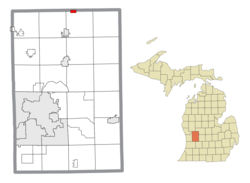2010 census
As of the census [2] of 2010, there were 500 people, 188 households, and 116 families living in the village. The population density was 625 per square mile. There were 211 housing units at an average density of 263.75 per square mile. The racial makeup of the village was 94.6% White, 0.80% African American, 0.2% Native American, 1% Asian, 1.4% from other races, and 2% from two or more races. Hispanic or Latino of any race were 5.2% of the population.
There were 188 households, of which 34% had children under the age of 18 living with them, 39.9% were married couples living together, 14.4% had a female householder with no husband present, and 38.3% were non-families. 33% of all households were made up of individuals, and 26.1% had someone living alone who was 65 years of age or older. The average household size was 2.66 and the average family size was 3.34.
In the village, the population was spread out, with 33% under the age of 20, 7% from 20 to 24, 23.4% from 25 to 44, 24.8% from 45 to 64, and 11.8% who were 65 years of age or older. The median age was 33.2 years. For every 100 females, there were 65.29 males. For every 100 females age 20 and over, there were 95.91 males.
2000 census
As of the census [2] of 2000, there were 492 people, 184 households, and 110 families living in the village. The population density was 670.5 inhabitants per square mile (258.9/km2). There were 207 housing units at an average density of 282.1 per square mile (108.9/km2). The racial makeup of the village was 96.34% White, 0.20% African American, 1.22% Native American, 0.81% Asian, 1.02% from other races, and 0.41% from two or more races. Hispanic or Latino of any race were 1.02% of the population.
There were 184 households, out of which 35.9% had children under the age of 18 living with them, 47.3% were married couples living together, 9.8% had a female householder with no husband present, and 40.2% were non-families. 34.2% of all households were made up of individuals, and 19.6% had someone living alone who was 65 years of age or older. The average household size was 2.64 and the average family size was 3.43.
In the village, the population was spread out, with 32.1% under the age of 18, 8.3% from 18 to 24, 28.7% from 25 to 44, 15.0% from 45 to 64, and 15.9% who were 65 years of age or older. The median age was 33 years. For every 100 females, there were 85.7 males. For every 100 females age 18 and over, there were 80.5 males.
The median income for a household in the village was $31,875, and the median income for a family was $46,250. Males had a median income of $27,500 versus $21,985 for females. The per capita income for the village was $14,184. About 9.3% of families and 14.5% of the population were below the poverty line, including 9.0% of those under age 18 and 34.0% of those age 65 or over.



